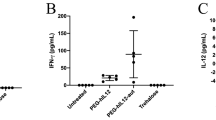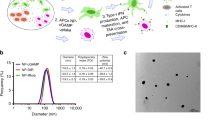Abstract
We have evaluated and compared the efficacy of systemic administration of lipoplex formulations containing plasmids encoding IFN-β or IFN-γ, and a synthetic double-strand RNA poly I:poly C (pI:pC), a type I IFN inducer, in a lung metastasis model in which colon carcinoma CT-26 cells were inoculated intravenously into immunocompatible mice. Injection of lipoplexes containing plasmid DNA, regardless of IFN gene insertion, stimulated a transient increase in the serum concentration of proinflammatory cytokines such as tumor necrosis factor (TNF)-α and IFN-γ, while injection of lipoplexes containing pI:pC led to a low level of TNF-α and undetectable IFN-γ production. Furthermore, injection of these lipoplexes containing plasmids resulted in the production of a mixture of type I and type II IFNs, partly derived from the inserted IFN genes, in lung tissue cultures. In tumor-prophylactic experiments, intravenous injection of lipoplexes containing plasmid, regardless of IFN gene insertion, showed a significant reduction in lung metastatic nodules probably due to proinflammatory cytokines such as TNF-α and IFN-γ nonspecifically induced by the CpG motifs in the plasmid and the type I IFNs produced. On the other hand, the antimetastatic effect of pI:pC-lipoplex seemed to be due mainly to IFN-β induced by pI:pC. In established lung metastasis experiments, a single intravenous administration of lipoplexes containing IFN-β gene or pI:pC, but not other lipoplexes, showed a significant therapeutic effect on the tumor metastasis: reduction in tumor nodules and prolongation of survival time of tumor-burden mice. The therapeutic effects were specifically impaired by anti-IFN-β antibody treatment, indicating that IFN-β produced by the lipoplexes played an important role in the suppression of established metastatic lung tumors. Thus, the local IFN-β in the lung delivered by intravenous administration of lipoplex containing IFN-β gene or pI:pC may be a convenient and useful method of inhibiting established metastatic lung tumors.
This is a preview of subscription content, access via your institution
Access options
Subscribe to this journal
Receive 12 print issues and online access
$259.00 per year
only $21.58 per issue
Buy this article
- Purchase on Springer Link
- Instant access to full article PDF
Prices may be subject to local taxes which are calculated during checkout






Similar content being viewed by others
References
Brassard DL, Grace MJ, Bordens RW . Interferon-alpha as an immunotherapeutic protein. J Leukoc Biol. 2002;71:565–581.
Gresser I, Belardelli F . Endogenous type I interferons as a defense against tumors. Cytokine Growth Factor Rev. 2002;13:111–118.
Ikeda H, Old LJ, Schreiber RD . The roles of IFN gamma in protection against tumor development and cancer immunoediting. Cytokine Growth Factor Rev. 2002;13:95–109.
Nemunaitis J, Fong T, Burrows F, et al. Phase I trial of interferon gamma retroviral vector administered intratumorally with multiple courses in patients with metastatic melanoma. Hum Gene Ther. 1999;10:1289–1298.
Nemunaitis J, Fong T, Robbins JM, et al. Phase I trial of interferon-gamma (IFN-gamma) retroviral vector administered intratumorally to patients with metastatic melanoma. Cancer Gene Ther. 1999;6:322–330.
Watanabe Y, Kuribayashi K, Miyatake S, et al. Exogenous expression of mouse interferon gamma cDNA in mouse neuroblastoma C1300 cells results in reduced tumorigenicity by augmented anti-tumor immunity. Proc Natl Acad Sci USA. 1989;86:9456–9460.
Fujii S, Huang S, Fong TC, et al. Induction of melanoma-associated antigen systemic immunity upon intratumoral delivery of interferon-gamma retroviral vector in melanoma patients. Cancer Gene Ther. 2000;7:1220–1230.
Cao G, Su J, Lu W, et al. Adenovirus-mediated interferon-beta gene therapy suppresses growth and metastasis of human prostate cancer in nude mice. Cancer Gene Ther. 2001;8:497–505.
Brown JL, Barsoum J, Qin XQ . CD4+ T helper cell-independent antitumor response mediated by murine IFN-beta gene delivery in immunocompetent mice. J Interferon Cytokine Res. 2002;22:719–728.
Iqbal Ahmed CM, Johnson DE, Demers GW, et al. Interferon alpha2b gene delivery using adenoviral vector causes inhibition of tumor growth in xenograft models from a variety of cancers. Cancer Gene Ther. 2001;8:788–795.
Izawa JI, Sweeney P, Perrotte P, et al. Inhibition of tumorigenicity and metastasis of human bladder cancer growing in athymic mice by interferon-beta gene therapy results partially from various antiangiogenic effects including endothelial cell apoptosis. Clin Cancer Res. 2002;8:1258–1270.
Natsume A, Mizuno M, Ryuke Y, et al. Antitumor effect and cellular immunity activation by murine interferon-beta gene transfer against intracerebral glioma in mouse. Gene Therapy. 1999;6:1626–1633.
Tada H, Maron DJ, Choi EA et al. Systemic IFN-beta gene therapy results in long-term survival in mice with established colorectal liver metastases. J Clin Invest. 2001;108:83–95.
Nomura T, Yasuda K, Yamada T, et al. Gene expression and antitumor effects following direct interferon (IFN)-gamma gene transfer with naked plasmid DNA and DC-chol liposome complexes in mice. Gene Therapy. 1999; 6:121–129.
Nemunaitis J, Bohart C, Fong T, et al. Phase I trial of retroviral vector-mediated interferon (IFN)-gamma gene transfer into autologous tumor cells in patients with metastatic melanoma. Cancer Gene Ther. 1998;5:292–300.
Templeton NS, Lasic DD, Frederik PM, et al. Improved DNA: liposome complexes for increased systemic delivery and gene expression. Nat Biotechnol. 1997;15:647–652.
Liu Y, Mounkes LC, Liggitt HD, et al. Factors influencing the efficiency of cationic liposome-mediated intravenous gene delivery. Nat Biotechnol. 1997;15:167–173.
Li S, Huang L . In vivo gene transfer via intravenous administration of cationic lipid-protamine-DNA (LPD) complexes. Gene Therapy. 1997;4:891–900.
Sakurai F, Nishioka T, Saito H, et al. Interaction between DNA–cationic liposome complexes and erythrocytes is an important factor in systemic gene transfer via the intravenous route in mice: the role of the neutral helper lipid. Gene Therapy. 2001;8:677–686.
Al-Mehdi AB, Tozawa K, Fisher AB, et al. Intravascular origin of metastasis from the proliferation of endothelium-attached tumor cells: a new model for metastasis. Nat Med. 2000;6:100–102.
Thurston G, McLean JW, Rizen M, et al. Cationic liposomes target angiogenic endothelial cells in tumors and chronic inflammation in mice. J Clin Invest. 1998;101:1401–1413.
Sakurai F, Terada T, Yasuda K, et al. The role of tissue macrophages in the induction of proinflammatory cytokine production following intravenous injection of lipoplexes. Gene Therapy. 2002;9:1120–1126.
Li S, Tseng WC, Stolz DB, et al. Dynamic changes in the characteristics of cationic lipidic vectors after exposure to mouse serum: implications for intravenous lipofection. Gene Therapy. 1999;6:585–594.
Kawabata K, Kondo M, Watanabe Y, et al. Non-polarized secretion of mouse interferon-beta from gene-transferred human intestinal Caco-2 cells. Pharm Res. 1997;14:483–485.
Watanabe Y, Kawade Y . Induction, production and purification of natural mouse IFN-α and -β. In: Clemens MJ, Morris AG, Gearing AJH, eds. Lymphokines and Interferons: A Practical Approach. Oxford: IRL Press; 1987: 1–14.
Kawade Y, Watanabe Y . Characterization of rat monoclonal antibodies to mouse interferon-α and -β. In: Cantell K, Schellekens H, eds. The Biology of the Interferon System 1987. Dordrecht: Martinus Nijhoff; 1987: 197–201.
Spitalny GL, Havell EA . Monoclonal antibody to murine gamma interferon inhibits lymphokine-induced antiviral and macrophage tumoricidal activities. J Exp Med. 1984; 159: 1560–1565.
Whitmore M, Li S, Huang L . LPD lipopolyplex initiates a potent cytokine response and inhibits tumor growth. Gene Therapy. 1999;6:1867–1875.
Dow SW, Elmslie RE, Fradkin LG, et al. Intravenous cytokine gene delivery by lipid–DNA complexes controls the growth of established lung metastases. Hum Gene Ther. 1999;10:2961–2972.
Dow SW, Fradkin LG, Liggitt DH, et al. Lipid–DNA complexes induce potent activation of innate immune responses and antitumor activity when administered intravenously. J Immunol. 1999;163:1552–1561.
Klinman DM, Yi AK, Beaucage SL, et al. CpG motifs present in bacteria DNA rapidly induce lymphocytes to secrete interleukin 6, interleukin 12, and interferon gamma. Proc Natl Acad Sci USA. 1996;93:2879–2883.
Ballas ZK, Rasmussen WL, Krieg AM . Induction of NK activity in murine and human cells by CpG motifs in oligodeoxynucleotides and bacterial DNA. J Immunol. 1996;157:1840–1845.
Sato Y, Roman M, Tighe H, et al. Immunostimulatory DNA sequences necessary for effective intradermal gene immunization. Science. 1996;273:352–354.
Ghazizadeh S, Carroll JM, Taichman LB . Repression of retrovirus-mediated transgene expression by interferons: implications for gene therapy. J Virol. 1997;71:9163–9169.
Qin L, Ding Y, Pahud DR, et al. Promoter attenuation in gene therapy: interferon-gamma and tumor necrosis factor-alpha inhibit transgene expression. Hum Gene Ther. 1997;8:2019–2029.
Liu Y, Thor A, Shtivelman E, et al. Systemic gene delivery expands the repertoire of effective antiangiogenic agents. J Biol Chem. 1999;274:13338–13344.
Yew NS, Zhao H, Przybylska M, et al. CpG-depleted plasmid DNA vectors with enhanced safety and long-term gene expression in vivo. Mol Ther. 2002;5:731–738.
Yasuda K, Ogawa Y, Kishimoto M, et al. Plasmid DNA activates murine macrophages to induce inflammatory cytokines in a CpG motif-independent manner by complex formation with cationic liposomes. Biochem Biophys Res Commun. 2002;293:344–348.
McLachlan G, Stevenson BJ, Davidson DJ, et al. Bacterial DNA is implicated in the inflammatory response to delivery of DNA/DOTAP to mouse lungs. Gene Therapy. 2000;7: 384–392.
Yew NS, Wang KX, Przybylska M, et al. Contribution of plasmid DNA to inflammation in the lung after administration of cationic lipid:pDNA complexes. Hum Gene Ther. 1999;10:223–234.
Dong Z, Juang SH, Kumar R, et al. Suppression of tumorigenicity and metastasis in murine UV-2237 fibrosarcoma cells by infection with a retroviral vector harboring the interferon-beta gene. Cancer Immunol Immunother. 1998;46: 137–146.
Lengyel P . Biochemistry of interferons and their actions. Annu Rev Biochem. 1982;51:251–282.
Gresser I . Antitumor effects of interferon. Acta Oncol. 1989;28:347–353.
Gao J, De BP, Banerjee AK . Human parainfluenza virus type 3 up-regulates major histocompatibility complex class I and II expression on respiratory epithelial cells: involvement of a STAT1- and CIITA-independent pathway. J Virol. 1999;73:1411–1418.
Targan S, Dorey F . Interferon activation of ‘pre-spontaneous killer’ (pre-SK) cells and alteration in kinetics of lysis of both ‘pre-SK’ and active SK cells. J Immunol. 1980;124:2157–2161.
Albini A, Marchisone C, Del Grosso F, et al. Inhibition of angiogenesis and vascular tumor growth by interferon-producing cells: a gene therapy approach. Am J Pathol. 2000;156:1381–1393.
Rosenblum MG, Yung WK, Kelleher PJ, et al. Growth inhibitory effects of interferon-beta but not interferon-alpha on human glioma cells: correlation of receptor binding, 2′,5′-oligoadenylate synthetase and protein kinase activity. J Interferon Res. 1990;10:141–151.
Johns TG, Mackay IR, Callister KA, et al. Antiproliferative potencies of interferons on melanoma cell lines and xenografts: higher efficacy of interferon beta. J Natl Cancer Inst. 1992;84:1185–1190.
Kobayashi N, Kuramoto T, Chen S, et al. Therapeutic effect of intravenous interferon gene delivery with naked plasmid DNA in murine metastasis models. Mol Ther. 2002;6:737–744.
Lowin-Kropf B, Held W . Positive impact of inhibitory Ly49 receptor-MHC class I interaction on NK cell development. J Immunol. 2000;165:91–95.
Esumi N, Hunt B, Itaya T, et al. Reduced tumorigenicity of murine tumor cells secreting gamma-interferon is due to nonspecific host responses and is unrelated to class I major histocompatibility complex expression. Cancer Res. 1991;51:1185–1189.
Lu H, Zhang Y, Roberts DD, et al. Enhanced gene expression in breast cancer cells in vitro and tumors in vivo. Mol Ther. 2002;6:783–792.
Kramer MG, Barajas M, Razquin N, et al. In vitro and in vivo comparative study of chimeric liver-specific promoters. Mol Ther. 2003;7:375–385.
Xu ZL, Mizuguchi H, Ishii-Watabe A, et al. Optimization of transcriptional regulatory elements for constructing plasmid vectors. Gene. 2001;272:149–156.
Acknowledgements
This work was supported in part by a grant-in-aid for Scientific Research from the Ministry of Education, Culture, Sports, Science and Technology, Japan.
Author information
Authors and Affiliations
Corresponding author
Rights and permissions
About this article
Cite this article
Sakurai, F., Terada, T., Maruyama, M. et al. Therapeutic effect of intravenous delivery of lipoplexes containing the interferon-β gene and poly I: poly C in a murine lung metastasis model. Cancer Gene Ther 10, 661–668 (2003). https://doi.org/10.1038/sj.cgt.7700617
Received:
Published:
Issue Date:
DOI: https://doi.org/10.1038/sj.cgt.7700617
Keywords
This article is cited by
-
Poly(I:C)-Mediated Tumor Growth Suppression in EGF-Receptor Overexpressing Tumors Using EGF-Polyethylene Glycol-Linear Polyethylenimine as Carrier
Pharmaceutical Research (2011)
-
Oncolytic measles viruses encoding interferon β and the thyroidal sodium iodide symporter gene for mesothelioma virotherapy
Cancer Gene Therapy (2010)
-
Targeting of products of genes to tumor sites using adoptively transferred A-NK and T-LAK cells
Cancer Gene Therapy (2007)
-
Cell and Tissue Targeting of Nucleic Acids for Cancer Gene Therapy
Pharmaceutical Research (2007)
-
Gene therapy for hepatocellular carcinoma using sonoporation enhanced by contrast agents
Cancer Gene Therapy (2005)



